Road barriers have evolved far beyond simple concrete blocks. Today, they are a critical part of road safety, protecting workers, drivers, and pedestrians around the globe.
Innovations in design, materials, and technology are shaping the way roads are managed, helping prevent accidents and save lives.
This article explores the top 10 innovations in road barriers and why they are transforming safety standards worldwide.
1. Water-Filled Barriers
Water-filled barriers are lightweight when empty, making them easy to transport and deploy. Once filled, they provide strong impact resistance for vehicles. Their flexibility makes them ideal for temporary construction zones, events, or detours.
Real-world insight: A South African roadwork project in Durban saw a 30% reduction in minor collisions after deploying water-filled barriers in high-traffic areas.
2. Modular Interlocking Barriers
Modular designs allow barriers to connect seamlessly, forming long continuous lines. They can be quickly installed or repositioned as work zones change, improving both safety and efficiency.
3. Energy-Absorbing Crash Cushions
These barriers reduce collision severity by absorbing impact energy. Often installed at the ends of medians or fixed objects, crash cushions prevent vehicles from rebounding into traffic.
4. Smart Barriers with Sensors
Smart barriers integrate sensors that detect collisions or unauthorized movement. These barriers can alert authorities instantly, providing real-time monitoring of construction zones or high-risk areas.
5. LED-Enhanced Visibility Barriers
LED lighting enhances nighttime visibility and alertness, reducing accidents in low-light conditions. Some systems are solar-powered, combining energy efficiency with improved road safety.
6. Portable Steel and Plastic Barriers
Portability is key for dynamic sites. Steel and plastic barriers are durable yet movable, offering protection without sacrificing flexibility. These barriers are often used in urban projects where traffic patterns change frequently.
7. Modular Pedestrian Barriers
Pedestrian safety is often overlooked in busy construction zones. Modular pedestrian barriers guide foot traffic safely past work areas, reducing the risk of accidental entry into hazardous zones.
8. Eco-Friendly Barriers
Sustainability is becoming a priority. Some barriers are now made from recycled materials, reducing environmental impact without compromising strength or durability.
9. High-Strength Concrete Barriers
Modern concrete barriers feature reinforced designs that withstand high-speed impacts. They are essential for highways, bridges, and areas with heavy traffic, providing reliable long-term protection.
10. Adaptive Traffic Barriers
The latest innovation involves barriers that adapt to traffic conditions. These systems can move, expand, or contract depending on lane closures or congestion, creating safer and more efficient traffic flow.
Case Study: Smart Barrier Deployment in Europe
A highway expansion in Germany used a combination of smart sensors, LED-enhanced barriers, and modular interlocking systems. The project recorded a 45% reduction in construction-zone incidents and smoother traffic flow during peak hours.
Project manager’s insight: “Integrating technology with traditional barrier design allowed us to react to changing traffic conditions while keeping workers safe.”
How These Innovations Impact Safety
Modern barrier technologies improve safety by:
- Preventing vehicles from entering hazardous zones
- Reducing collision severity through energy absorption
- Guiding traffic efficiently and clearly
- Enhancing visibility in challenging conditions
- Supporting pedestrian safety in urban environments
These innovations are not just technical upgrades—they represent a shift toward proactive, intelligent road safety planning.
Key Takeaways
- Road barrier innovations are saving lives by improving safety and visibility.
- Modular and portable designs provide flexibility for dynamic work zones.
- Smart barriers with sensors offer real-time monitoring and rapid response.
- Energy-absorbing and reinforced barriers reduce collision severity.
- Sustainable and eco-friendly materials are increasingly common in modern barriers.
FAQs About Road Barrier Innovations
What is the most common barrier used on highways?
High-strength reinforced concrete barriers are standard for high-speed or high-traffic areas due to durability and impact resistance.
Can smart barriers prevent accidents completely?
No barrier can eliminate accidents entirely, but smart barriers reduce risks by providing alerts and guiding drivers effectively.
Are water-filled barriers safe for urban areas?
Yes, especially for temporary or low-speed zones. They are portable and highly visible.
How do LED barriers improve safety?
LED lighting increases visibility in low-light conditions and alerts drivers to lane changes or construction zones.
Are eco-friendly barriers as reliable as traditional materials?
Yes. Modern eco-friendly barriers are tested for strength and impact resistance while offering environmental benefits.
Conclusion
Road barriers have transformed from simple concrete blocks into intelligent safety systems that combine engineering, technology, and sustainability. Innovations such as smart sensors, energy-absorbing materials, and adaptive designs are creating safer roads worldwide.
For construction managers, traffic engineers, and urban planners, understanding these innovations is critical. The right barrier technology protects lives, improves traffic flow, and ensures projects run efficiently.

